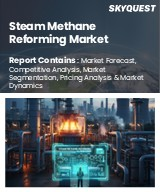
|
시장보고서
상품코드
1438175
세계 수소 시장 예측(-2030년) : 유형별, 저장별, 수송별, 용도별, 지역별 분석Hydrogen Market Forecasts to 2030 - Global Analysis By Type (Green Hydrogen, Gray Hydrogen, Blue Hydrogen, Brown Hydrogen and Other Types), Storage, Transportation, Application and By Geography |
||||||
Stratistics MRC에 따르면 세계 수소 시장은 2023년에 2,427억 달러를 차지했으며, 2030년에는 4,669억 달러에 이르고, 예측 기간 동안 CAGR 9.8%로 성장할 것으로 예상됩니다. 수소는 우주에서 가장 간단하고 풍부한 무색, 무취, 매우 가연성의 기체입니다. 원자상에서는 수소는 양성자 1개와 전자 1개로 구성되어 있습니다. 물 분자(H2O)와 다양한 유기 화합물에 많이 포함되어 있습니다. 수소는 에너지 캐리어로서의 만능성, 연료전지 및 청정에너지 용도에서의 이용 가능성에서부터 연료생산에서 화학·에너지 분야까지 다양한 산업에서 중요한 역할을 하고 있습니다.
신·재생 가능 에너지성에 따르면 국가 수소 미션에 의해 2030년까지 수소 총 수요에서 차지하는 그린 수소의 점유율을 46%까지 높일 가능성이 있으며, 2025년부터 2030년까지 시장 점유율은 더욱 높아지면 예상됩니다.
산업계의 탈탄소화
산업계에서의 탈탄소화는 클린 에너지로서 수소로의 시프트를 가속시키고 있습니다. 수송, 제조, 에너지 등의 산업은 그 제로 방출의 가능성으로부터 수소를 채택하고 있습니다. 시장은 급속히 확대되고 있으며 생산, 저장, 인프라에 대한 투자가 증가하고 있습니다. 연료 및 에너지 캐리어로서의 수소의 다용도는 다양한 분야의 탈탄소화, 혁신의 추진, 세계의 지속가능한 에너지 전환을 촉진하는데 있어 매우 중요한 요소입니다.
다른 기술과의 경쟁
시장은 그 성숙도와 확장성으로부터 에너지 저장 분야의 배터리와 같은 기존 기술과의 엄격한 경쟁에 직면하고 있습니다. 또한 태양광 발전과 풍력 발전과 같은 대체 청정 에너지 원의 진보가 재생 가능 에너지 분야에서 경쟁을 일으키고 있습니다. 인프라 정비와 비용 효과적인 과제도 이러한 기술에 대한 수소 경쟁에 영향을 미치며 시장에서 틈새 시장을 개척하는 지속적인 기술 혁신과 투자가 필요합니다.
신재생에너지 통합
재생 가능 에너지의 통합은 수소 시장 형성에 매우 중요합니다. 풍력, 태양광 및 기타 재생 가능 에너지를 전해조의 전력원으로 활용함으로써 수소 제조는 더욱 깨끗하고 지속 가능합니다. 이러한 수단으로 생성된 그린 수소는 화석연료를 대체하는 환경친화적인 대체연료가 됩니다. 이 통합은 시장 성장을 가속하고 수소 기술의 발전을 촉진하고 이산화탄소 배출량을 줄이고 지속 가능한 에너지 환경을 촉진합니다.
제조 비용
수소 시장의 제조 비용은 사용하는 방법에 따라 다릅니다. 고온 전해 및 광전기화학 공정과 같은 첨단 방법은 향후 비용을 절감할 수 있습니다. 비용은 에너지 가격, 기술 진보, 생산 규모의 영향을 받고 에너지 캐리어로서 수소 경쟁에 영향을 미칩니다. 이것이 시장 성장을 억제하는 요인입니다.
COVID-19의 영향
COVID-19의 대유행은 공급망의 혼란과 투자 감소로 인해 처음에는 수소 시장의 성장을 둔화시켰습니다. 그러나 그 후, 녹색 부흥에 대한 관심이 높아졌고, 청정 에너지 솔루션에서 수소의 역할이 높아졌습니다. 각국 정부는 경기자극책 가운데 수소 인프라를 강조하여 그린 수소 제조 기술에 대한 혁신과 투자를 촉진했습니다. 전반적으로 팬데믹은 촉매의 역할을 했고 단기적인 좌절에도 불구하고 지속 가능한 에너지 전환에서 매우 중요한 선수로서 수소에 대한 관심을 높였습니다.
예측기간 동안 녹색수소분야가 최대가 될 전망
예측 기간 동안 그린 수소 분야가 최대가 될 전망입니다. 풍력발전이나 태양광 발전과 같은 재생가능한 자원으로부터 전기분해에 의해 얻어지는 그린 수소는 시장에 혁명을 가져오고 있습니다. 탄소를 배출하지 않는 환경 친화적인 제조 방법이기 때문에 화석 연료에 의존하는 기존의 수소 제조 방법을 대신하는 지속 가능한 선택이 되고 있습니다. 탈탄소화와 재생가능에너지에 대한 세계의 주목이 높아지고 있는 가운데, 녹색수소는 깨끗한 에너지 솔루션을 제공하고, 이산화탄소 배출량을 삭감하고, 보다 지속 가능한 미래를 키워 산업을 재형성 하는 태세를 정돈하고 있습니다.
예측기간 동안 에너지분야의 CAGR이 가장 높아질 전망
예측 기간 동안 에너지 분야의 CAGR이 가장 높을 것으로 예상됩니다. 탈탄소화에 대한 주목이 높아지는 가운데 수송, 발전, 제조 등 산업에서 수소의 범용성이 수요를 가속화하고 있습니다. 수소 인프라 투자, 전해 및 연료전지 기술 진보, 정부 지원 정책이 시장 성장을 가속하고 있습니다. 정부의 지원, 혁신적인 프로젝트, 업계 간의 파트너십이 역동적인 상황을 형성하고 있으며, 수소는 지속 가능한 에너지로 세계를 변화시키는 중요한 선수로 자리매김하고 있습니다.
최대 점유율을 차지하는 지역
예측 기간 동안 북미가 가장 큰 시장 점유율을 차지할 것으로 예측됩니다. 정부 이니셔티브와 민간 부문의 협력은 특히 수송과 산업 부문에서 수소 인프라 정비를 촉진하고 있습니다. 전기분해와 재생가능 에너지원의 진보는 이 지역의 수소경제 확대에 기여하고 있습니다. 시장 기업은 지속 가능한 대체 에너지에 대한 수요 증가에 대응하기 위해 생산 규모의 확대와 유통망의 강화에 적극적으로 노력하고 있습니다.
CAGR이 가장 높은 지역:
예측 기간 동안 아시아태평양의 CAGR이 가장 높을 것으로 예측됩니다. 주요 요인으로는 수소 도입을 촉진하는 정부의 이니셔티브, 신재생에너지 투자 확대, 수소기반 수송수단의 등장 등이 있습니다. 업계 관계자간의 협력 관계와 기술의 진보가 시장 확대를 더욱 뒷받침해, 이 지역은 수소의 기술 혁신과 보급의 극히 중요한 거점으로 자리매김하고 있습니다.
무료 맞춤 서비스
이 보고서를 구독하는 고객은 다음 무료 맞춤설정 옵션 중 하나를 사용할 수 있습니다.
- 기업 프로파일
- 추가 시장 기업의 종합적 프로파일링(3개사까지)
- 주요 기업의 SWOT 분석(3개사까지)
- 지역 세분화
- 고객의 관심에 응한 주요국 시장 추계·예측·CAGR(주: 타당성 확인에 따름)
- 경쟁 벤치마킹
- 제품 포트폴리오, 지리적 존재, 전략적 제휴에 기반한 주요 기업 벤치마킹
목차
제1장 주요 요약
제2장 서문
- 개요
- 이해관계자
- 조사 범위
- 조사 방법
- 데이터 마이닝
- 데이터 분석
- 데이터 검증
- 조사 접근
- 조사 소스
- 1차 조사 소스
- 2차 조사 소스
- 전제조건
제3장 시장 동향 분석
- 성장 촉진요인
- 억제요인
- 기회
- 위협
- 용도 분석
- 신흥 시장
- COVID-19의 영향
제4장 Porter's Five Forces 분석
- 공급기업의 협상력
- 구매자의 협상력
- 대체품의 위협
- 신규 참가업체의 위협
- 경쟁 기업간 경쟁 관계
제5장 세계의 수소 시장 : 유형별
- 그린 수소
- 그레이 수소
- 블루 수소
- 브라운 수소
- 기타 유형
제6장 세계의 수소 시장 : 저장별
- 물리적
- 소재 베이스
제7장 세계의 수소 시장 : 수송별
- 장거리
- 근거리
제8장 세계의 수소 시장 : 용도별
- 가동성
- 에너지
- 화학 및 정유소
- 메탄올 제조
- 암모니아 생성
- 석유 정제소
- 기타 용도
제9장 세계의 수소 시장 : 지역별
- 북미
- 미국
- 캐나다
- 멕시코
- 유럽
- 독일
- 영국
- 이탈리아
- 프랑스
- 스페인
- 기타 유럽
- 아시아태평양
- 일본
- 중국
- 인도
- 호주
- 뉴질랜드
- 한국
- 기타 아시아태평양
- 남미
- 아르헨티나
- 브라질
- 칠레
- 기타 남미
- 중동 및 아프리카
- 사우디아라비아
- 아랍에미리트(UAE)
- 카타르
- 남아프리카
- 기타 중동 및 아프리카
제10장 주요 발전
- 계약/파트너십/협업/합작투자(JV)
- 인수와 합병
- 신제품 발매
- 사업 확대
- 기타 주요 전략
제11장 기업 프로파일
- Ballard Power Systems
- Mahler AGS GmbH
- Teledyne Technologies Incorporated,
- Linde plc.
- Air Liquide
- Air Products & Chemicals Inc
- Cummins Inc
- Iwatani Corporation
- Messer Group GmbH
- Plug Power Inc
- Siemens Energy
- Nel ASA
- ITM Power PLC
- Green Hydrogen Systems
According to Stratistics MRC, the Global Hydrogen Market is accounted for $242.7 billion in 2023 and is expected to reach $466.9 billion by 2030 growing at a CAGR of 9.8% during the forecast period. Hydrogen is the simplest and most abundant element in the universe. It's a colorless, odorless, and highly flammable gas. In its atomic form, hydrogen consists of a single proton and a single electron. It's commonly found in water molecules (H2O) and various organic compounds. Hydrogen plays a significant role in various industries, from fuel production to the chemical and energy sectors due to its versatility as an energy carrier and its potential for use in fuel cells and clean energy applications.
According to the Ministry of New and Renewable Energy, the national hydrogen mission could potentially increase green hydrogen's share in this total hydrogen demand to 46% by 2030, which is further anticipated to enhance the market share during 2025-2030.
Market Dynamics:
Driver:
Decarbonization in industries
Decarbonization in industries is accelerating the shift towards hydrogen as a clean energy source. Industries like transportation, manufacturing, and energy are adopting hydrogen due to its zero-emission potential. The market is expanding rapidly, with increased investments in production, storage, and infrastructure. Its versatility as a fuel and energy carrier positions hydrogen as a pivotal element in decarbonizing various sectors, driving innovation and fostering a sustainable energy transition worldwide.
Restraint:
Competition with other technologies
The market faces stiff competition from established technologies like batteries in the energy storage sector due to their maturity and scalability. Additionally, the advancement of alternative clean energy sources, such as solar and wind power, poses competition in the realm of renewable energy. Challenges in infrastructure development and cost-effectiveness also affect hydrogen's competitiveness against these technologies, demanding continual innovation and investment to carve its niche in the market.
Opportunity:
Renewable energy integration
Renewable energy integration is pivotal in shaping the hydrogen market. Utilizing wind, solar, and other renewable sources to power electrolyzers, hydrogen production becomes cleaner and sustainable. Green hydrogen, generated through these means, offers an eco-friendly alternative to fossil fuels. This integration fosters market growth, driving advancements in hydrogen technologies, reducing carbon footprints, and promoting a more sustainable energy landscape.
Threat:
Production costs
The production costs in the hydrogen market vary depending on the method used. Advanced methods like high-temperature electrolysis or photoelectrochemical processes may offer potential cost reductions in the future. Costs are influenced by energy prices, technology advancements, and scale of production, impacting the competitiveness of hydrogen as an energy carrier. This is the factor restraining the growth of the market.
Covid-19 Impact:
The COVID-19 pandemic initially slowed the hydrogen market's growth due to disrupted supply chains and decreased investments. However, it later spurred interest in green recovery, elevating hydrogen's role in clean energy solutions. Governments emphasized hydrogen infrastructure in stimulus plans, fostering innovation and investment in green hydrogen production technologies. Overall, the pandemic acted as a catalyst, redirecting attention to hydrogen as a pivotal player in sustainable energy transitions despite short-term setbacks.
The green hydrogen segment is expected to be the largest during the forecast period
The green hydrogen segment is expected to be the largest during the forecast period. Green hydrogen, derived from renewable sources like wind or solar power through electrolysis, is revolutionizing the market. Its eco-friendly production method, emitting no carbon, makes it a sustainable alternative to traditional hydrogen production methods reliant on fossil fuels. With increasing global focus on decarbonization and renewable energy, green hydrogen is gaining traction, poised to reshape industries by offering a clean energy solution, reducing carbon footprints, and fostering a more sustainable future.
The energy segment is expected to have the highest CAGR during the forecast period
The energy segment is expected to have the highest CAGR during the forecast period. With increasing focus on decarbonization, hydrogen's versatility across industries like transportation, power generation, and manufacturing is accelerating its demand. Investments in hydrogen infrastructure, technological advancements in electrolysis and fuel cells, alongside supportive government policies, are fostering market growth. Government support, innovative projects, and partnerships between industries are shaping a dynamic landscape, positioning hydrogen as a key player in the global shift toward sustainable energy.
Region with largest share:
North America is projected to hold the largest market share during the forecast period. Government initiatives and private sector collaborations have fuelled the development of hydrogen infrastructure, especially in transportation and industrial sectors. Advancements in electrolysis and renewable energy sources contribute to the region's expanding hydrogen economy. Market players are actively engaged in scaling up production and enhancing distribution networks to meet the rising demand for sustainable energy alternatives.
Region with highest CAGR:
Asia Pacific is projected to hold the highest CAGR over the forecast period. Key factors include government initiatives promoting hydrogen adoption, expanding investments in renewable energy, and the rise of hydrogen-based transportation. Collaborations between industry players and advancements in technology further propel market expansion, positioning the region as a pivotal hub for hydrogen innovation and deployment.
Key players in the market
Some of the key players in Hydrogen market include Ballard Power Systems, Mahler AGS GmbH, Teledyne Technologies Incorporated, Linde plc., Air Liquide, Air Products & Chemicals Inc, Cummins Inc, Iwatani Corporation, Messer Group GmbH, Plug Power Inc, Siemens Energy, Nel ASA, ITM Power PLC, and Green Hydrogen Systems.
Key Developments:
In July 2023, Air Products & Chemicals, Inc. announced that it has been chosen as the hydrogen and technology provider for Alberta's first hydrogen fuel cell passenger vehicle fleet by Edmonton International Airport. Air Products will deploy a mobile hydrogen refueler at the airport to deliver hydrogen for the Toyota Mirai hydrogen fuel cell vehicle fleet.
In July 2023, Air Liquide and KBR collaborated to provide fully integrated low-carbon ammonia solutions based on Autothermal Reforming (ATR) technology. Air Liquide is a global leader in ATR technology, which is one of the best options for large-scale production of low-carbon hydrogen (H2), which is then mixed with nitrogen (N2) to make low-carbon ammonia (NH3).
In April 2023, Linde plc has signed a long-term arrangement with Evonik, a well-known specialty chemicals firm, to supply green hydrogen. Linde will build, own, and operate a nine-megawatt alkaline electrolyzer facility on Jurong Island in Singapore under this arrangement. This plant's major output will be green hydrogen, which Evonik wants to employ in the synthesis of methionine, an essential element in animal feed.
Types Covered:
- Green Hydrogen
- Gray Hydrogen
- Blue Hydrogen
- Brown Hydrogen
- Other Types
Storages Covered:
- Physical
- Material Based
Transportations Covered:
- Long Distance
- Short Distance
Applications Covered:
- Mobility
- Energy
- Chemical & Refinery
- Other Applications
Regions Covered:
- North America
- US
- Canada
- Mexico
- Europe
- Germany
- UK
- Italy
- France
- Spain
- Rest of Europe
- Asia Pacific
- Japan
- China
- India
- Australia
- New Zealand
- South Korea
- Rest of Asia Pacific
- South America
- Argentina
- Brazil
- Chile
- Rest of South America
- Middle East & Africa
- Saudi Arabia
- UAE
- Qatar
- South Africa
- Rest of Middle East & Africa
What our report offers:
- Market share assessments for the regional and country-level segments
- Strategic recommendations for the new entrants
- Covers Market data for the years 2021, 2022, 2023, 2026, and 2030
- Market Trends (Drivers, Constraints, Opportunities, Threats, Challenges, Investment Opportunities, and recommendations)
- Strategic recommendations in key business segments based on the market estimations
- Competitive landscaping mapping the key common trends
- Company profiling with detailed strategies, financials, and recent developments
- Supply chain trends mapping the latest technological advancements
Free Customization Offerings:
All the customers of this report will be entitled to receive one of the following free customization options:
- Company Profiling
- Comprehensive profiling of additional market players (up to 3)
- SWOT Analysis of key players (up to 3)
- Regional Segmentation
- Market estimations, Forecasts and CAGR of any prominent country as per the client's interest (Note: Depends on feasibility check)
- Competitive Benchmarking
- Benchmarking of key players based on product portfolio, geographical presence, and strategic alliances
Table of Contents
1 Executive Summary
2 Preface
- 2.1 Abstract
- 2.2 Stake Holders
- 2.3 Research Scope
- 2.4 Research Methodology
- 2.4.1 Data Mining
- 2.4.2 Data Analysis
- 2.4.3 Data Validation
- 2.4.4 Research Approach
- 2.5 Research Sources
- 2.5.1 Primary Research Sources
- 2.5.2 Secondary Research Sources
- 2.5.3 Assumptins
3 Market Trend Analysis
- 3.1 Introduction
- 3.2 Drivers
- 3.3 Restraints
- 3.4 Opportunities
- 3.5 Threats
- 3.6 Application Analysis
- 3.7 Emerging Markets
- 3.8 Impact of Covid-19
4 Porters Five Force Analysis
- 4.1 Bargaining power of suppliers
- 4.2 Bargaining power of buyers
- 4.3 Threat of substitutes
- 4.4 Threat of new entrants
- 4.5 Competitive rivalry
5 Global Hydrogen Market, By Type
- 5.1 Introduction
- 5.2 Green Hydrogen
- 5.3 Gray Hydrogen
- 5.4 Blue Hydrogen
- 5.5 Brown Hydrogen
- 5.6 Other Types
6 Global Hydrogen Market, By Storage
- 6.1 Introduction
- 6.2 Physical
- 6.3 Material Based
7 Global Hydrogen Market, By Transportation
- 7.1 Introduction
- 7.2 Long Distance
- 7.3 Short Distance
8 Global Hydrogen Market, By Application
- 8.1 Introduction
- 8.2 Mobility
- 8.3 Energy
- 8.4 Chemical & Refinery
- 8.4.1 Methanol Production
- 8.4.2 Ammonia Production
- 8.4.3 Petroleum Refinery
- 8.5 Other Applications
9 Global Hydrogen Market, By Geography
- 9.1 Introduction
- 9.2 North America
- 9.2.1 US
- 9.2.2 Canada
- 9.2.3 Mexico
- 9.3 Europe
- 9.3.1 Germany
- 9.3.2 UK
- 9.3.3 Italy
- 9.3.4 France
- 9.3.5 Spain
- 9.3.6 Rest of Europe
- 9.4 Asia Pacific
- 9.4.1 Japan
- 9.4.2 China
- 9.4.3 India
- 9.4.4 Australia
- 9.4.5 New Zealand
- 9.4.6 South Korea
- 9.4.7 Rest of Asia Pacific
- 9.5 South America
- 9.5.1 Argentina
- 9.5.2 Brazil
- 9.5.3 Chile
- 9.5.4 Rest of South America
- 9.6 Middle East & Africa
- 9.6.1 Saudi Arabia
- 9.6.2 UAE
- 9.6.3 Qatar
- 9.6.4 South Africa
- 9.6.5 Rest of Middle East & Africa
10 Key Developments
- 10.1 Agreements, Partnerships, Collaborations and Joint Ventures
- 10.2 Acquisitions & Mergers
- 10.3 New Product Launch
- 10.4 Expansions
- 10.5 Other Key Strategies
11 Company Profiling
- 11.1 Ballard Power Systems
- 11.2 Mahler AGS GmbH
- 11.3 Teledyne Technologies Incorporated,
- 11.4 Linde plc.
- 11.5 Air Liquide
- 11.6 Air Products & Chemicals Inc
- 11.7 Cummins Inc
- 11.8 Iwatani Corporation
- 11.9 Messer Group GmbH
- 11.10 Plug Power Inc
- 11.11 Siemens Energy
- 11.12 Nel ASA
- 11.13 ITM Power PLC
- 11.14 Green Hydrogen Systems



















